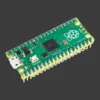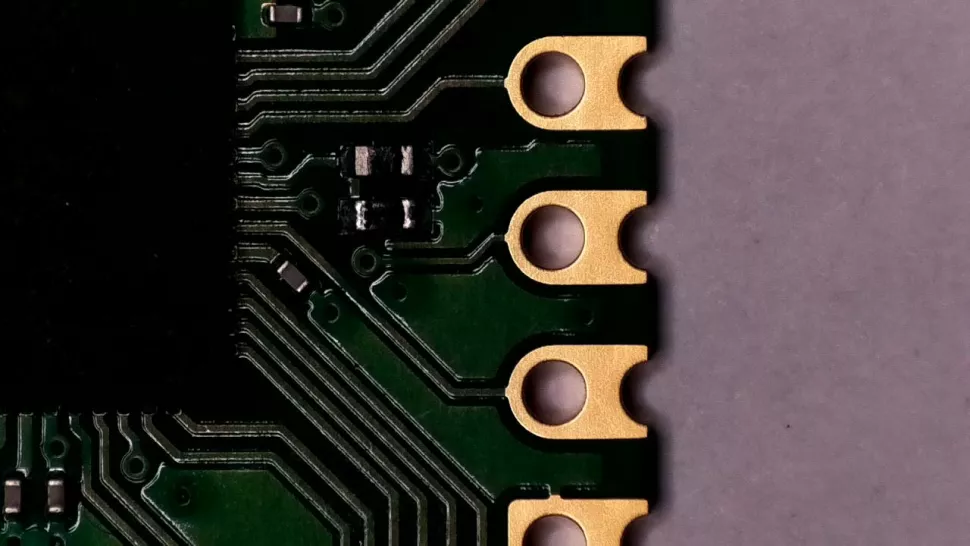The Raspberry Pi Pico series is a range of tiny, fast, and versatile boards built using the RP2040, the flagship microcontroller chip designed by Raspberry Pi in the UK.

Raspberry Pi Pico is the company's first microcontroller-class board. Pico delivers our signature values of high performance, low cost, and simplicity of use to the microcontroller space thanks to our RP2040 silicon platform.
The RP2040 offers professional users unrivaled power and flexibility because of its huge on-chip memory, symmetric dual-core CPU complex, deterministic bus fabric, and rich peripheral set enhanced by our unique Programmable I/O (PIO) subsystem. It offers the lowest entry barrier for novice and hobbyist users thanks to comprehensive documentation, a solid MicroPython port, and a UF2 bootloader in ROM.
The RP2040 is produced on a modern 40nm process node, offering great performance, low dynamic power consumption, and low leakage, as well as a variety of low-power modes to support extended-duration operation on battery power.
A power supply chip supporting input voltages between 1.8 and 5.5 volts is combined with an RP2040 with 2MB of flash memory. It offers 26 GPIO pins, three of which may function as analog inputs, on 0.1″-pitch through-hole pads with castellated edges. Raspberry Pi Pico is offered as a single unit or in 480-unit reels for automated assembly.
What Is a Raspberry Pi Pico?
A new low-cost microcontroller called Raspberry Pi Pico was created by Raspberry Pi. With onboard memory and programmable in and out ports, it is a tiny computer based on a single chip. Microcontrollers have historically been used in a variety of gadgets, from power tools to medical implants. There's a considerable possibility that if you have an electrical gadget sitting nearby, it has a microcontroller.
Key Features of the Pico
The Pico is based on Raspberry Pi's UK-designed RP2040 microcontroller chip. It is a dual-core ARM processor with a variable clock that can run at up to 133 MHz. The Pico also features a micro-USB input connector, and an onboard temperature sensor, and supports a 1.8–5.5 DC input voltage.
A series of castellations surround the chip, making soldering to a breadboard or Vero board simple. This dual in-line package (DIP) style form factor is stackable and may be used in carrier board applications.
From light displays and IoT devices to signage and manufacturing processes, the Raspberry Pi Pico series gives you the power to control countless home, hobby, and industrial operations.
Programmable in C and MicroPython, Pico is adaptable to a vast range of applications and skill levels, and getting started is as easy as dragging and dropping a file.
More experienced users can take advantage of Raspberry Pi Pico's rich peripheral set, including SPI, I2C, and eight Programmable I/O (PIO) state machines for custom peripheral support.
Now available with wireless connectivity or pre-soldered headers, for even more flexibility in your projects.
What’s So Special About the Pi Pico?
An alternative sort of microcontroller is the Pi Pico. It is the first Raspberry Pi, and its RP2040 silicon chip uses ARM technology. Major technology manufacturers like Apple are leading the way in using ARM-based silicon processors.
The punchy, tiny Pico packs a staggering 26 multifunction general-purpose input/output (GPIO) ports, including three analog ones. Eight programmable input/output (PIO) ports are located next to these ports. The Pico packs roughly 18% more GPIO functionality than competing microcontrollers like the Arduino Nano.
The $4 price tag, though, is the biggest difference between the Pico and its rivals. This unique offering's key selling point is its low cost.
Due to demand and Raspberry Pi's positive reputation, several online retailers sold out of the product at launch. The Pico opens the door for a new class of powerful, affordable microcontrollers by setting the price so low.
The new Pico has a wide range of potential uses. The device is an obvious candidate for Internet of Things applications given its onboard temperature sensor.
A talented retro gaming enthusiast even constructed a console with full VGA video capabilities using a Pico.
This means that makers who have been interested in Raspberry Pi or microcontrollers, in general, may now explore for less than the price of a fancy cup of coffee.
The Raspberry Pi Pico Processor

An interesting choice for the Pico is the RP2040 ARM chip. The chip is capable of leaving more expensive boards, such as the Arduino Uno, in the dust at 133 MHz.
In the world of microcontrollers, using ARM processors seems to be a growing trend. Both Sparkfun and Adafruit provide boards with similar ARM technology in addition to the Raspberry Pi.
The switch was implemented across the board for a single reason: speed. Compared to standard Atmel chips, ARM processors provide a significant improvement. An ARM CPU on a board this tiny is equivalent to installing a completely customized Porsche engine in a VW. Yet, a lot of microcontrollers don't require that much processing speed. Yet.
Ramping up performance means makers will have an abundance of power to push Pico's limits.
Warnings
- Any external power supply used with the Raspberry Pi Pico shall comply with relevant regulations and standards applicable in the country of intended use.
- This product should be operated in a well-ventilated environment, and if used inside a case, the case should not be covered.
- While in use, this product should be placed on a stable, flat, non-conductive surface and should not be contacted by conductive items.
- The connection of incompatible devices to the Raspberry Pi Pico may affect compliance, result in damage to the unit, and invalidate the warranty.
- All accessories used with this product should comply with relevant standards for the country of use and be marked accordingly to ensure that safety and performance requirements are met.
- The cables and connectors of all peripherals used with this product must have adequate insulation so that relevant safety requirements are met.
Safety Instructions
To avoid malfunction or damage to this product, please observe the following:
- Take care while handling to avoid mechanical or electrical damage to the printed circuit board and connectors.
- Do not expose to water or moisture or place on a conductive surface whilst in operation.
- While it is powered, avoid handling the printed circuit board or only handle it by the corners to minimize the risk of electrostatic discharge damage.
- Do not expose to heat from any source; the Raspberry Pi Pico is designed for reliable operation at normal ambient temperatures.
Design of the Raspberry Pi Pico
The Raspberry Pi Pico first strikes us as resembling a more modern Arduino microcontroller, an Adafruit Feather, or a Teensy board. The Pico deviates from the typical Raspberry Pi in terms of design and user interface. It functions and seems like a typical microcontroller. The Raspberry Pi Pico is smaller than the Raspberry Pi Zero, measuring 2 by 0.8 inches (51 x 21 mm).
The Raspberry Pi Pico's 40 pins are unsoldered since they are intended for use with breadboards and surface mount carrier boards; thus, we must use a soldering iron to connect them. If we want to integrate the Pico into a project, we may solder the cancellations to pads on the carrier board or attach our header pins to the Pico.
These mini breadboards are of little value since using the Raspberry Pi Pico with a breadboard requires a half-size or larger breadboard.
James Adams tells us more about the Raspberry Pi Pico design. “The Pico was designed to be as compact, inexpensive, and beginner-friendly as possible. The board is the same length and one 0.1 thick; we see it as both a development board and a component in and of itself (since it may be soldered down as an SMT module using the castellated edge pads), with a pitch that is wider than a standard 40-pin DIP (Dual Inline Package).
Might the Pico lead to the creation of its add-on standard, in the same vein as the Raspberry Pi HAT or Arduino Shield standards? It seems that the Pico is most likely to be incorporated into carrier boards, one of which is already being used internally at Raspberry Pi, and others are actively being developed with third parties; these carrier boards would give additional capabilities depending on their intended usage.
Raspberry Pi Pico FAQ
No, it doesn’t by default. But you can add Ethernet yourself.
Raspberry Pi has officially released a guide, which you can follow to install ethernet on your Raspberry Pi Pico.
In essence, you need an RMII Ethernet PHY such as a LAN8720, a breadboard, and jumper wires. Your Raspberry Pi Pico must also have headers soldered.
No, but you can install it using aftermarket parts. One compatible chip that will help you get WiFi capability is the Adafruit Airlift WiFi Featherwing Co-Processor.
Yes, the Raspberry Pi Pico has a micro USB port. It can be used to power the Raspberry Pi.
Furthermore, you can also use the Raspberry Pi Pico as a human interaction device. Connecting it to your computer with the proper components and code can allow it to become a joystick, macro keyboard, toggle, etc.
No, but you can install it using aftermarket parts.
Typically, integrating Bluetooth on the Raspberry Pi Pico requires you to buy a Bluetooth module such as the HC-06 Bluetooth Module.
Yes, you can integrate the Raspberry Pi Pico with a camera module.
A camera that you can use is the HM01B0 camera from Himax Imaging. The benefit of using this is that it’s extremely low-powered, using 1-2 milliwatts according to Ralph Yamamoto, who wrote about his experience getting a camera to work with the Raspberry Pi Pico.















